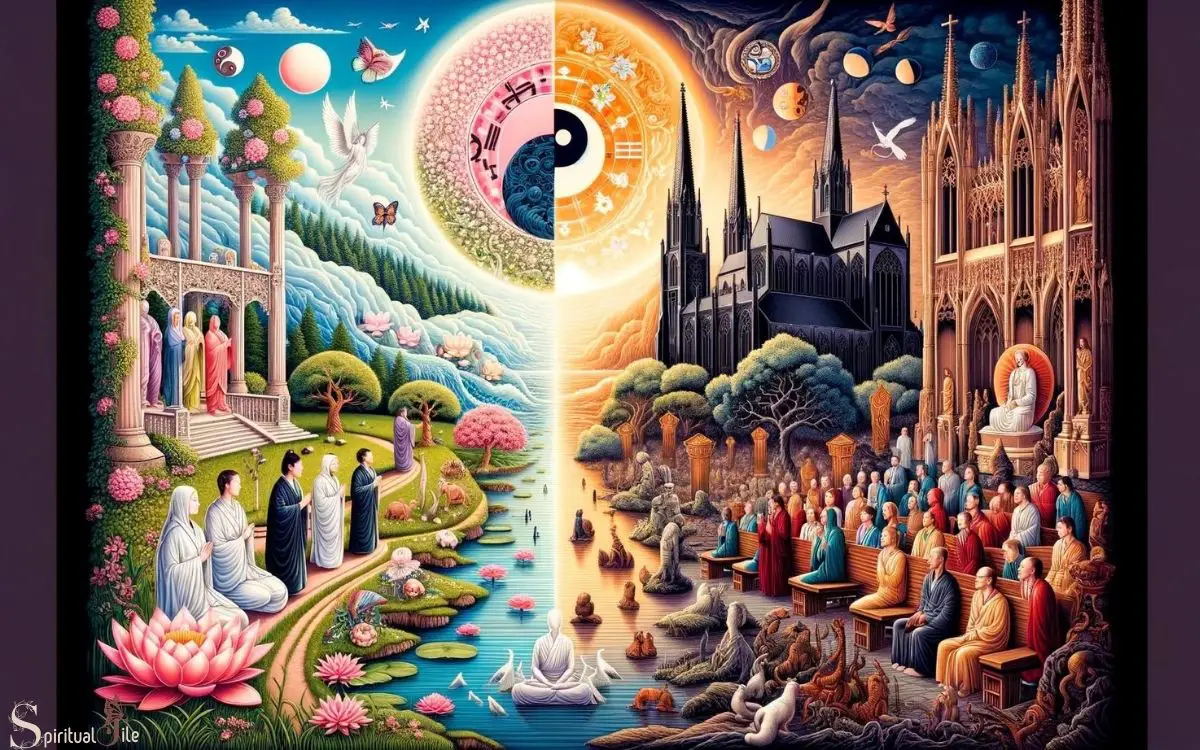Eastern Spirituality Vs Western: Human Consciousness!
Exploring the Distinctive Paths to Enlightenment: Eastern Spirituality Versus Western Ideology
Eastern spirituality and Western ideology offer unique and contrasting approaches to understanding human consciousness and the journey towards inner peace.
Eastern practices often emphasize interconnectedness, mindfulness, and a holistic approach to well-being, while Western ideologies typically focus on individualism, analytical thought, and a goal-oriented outlook on progress and success.
Eastern spirituality, encompassing diverse traditions like Buddhism, Hinduism, and Taoism, tends to stress the importance of inner balance, meditation, and the relinquishment of material attachment.

Key Takeaway
Historical Origins

The historical origins of Eastern spirituality and Western spirituality can be traced back to distinct cultural and philosophical traditions.
Eastern spirituality, rooted in ancient Indian and East Asian traditions, emphasizes the interconnectedness of all things, the pursuit of inner peace, and the concept of karma. This tradition encompasses practices such as Buddhism, Hinduism, Taoism, and Zen meditation.
On the other hand, Western spirituality has its roots in the monotheistic traditions of Judaism, Christianity, and Islam. It places a strong emphasis on the relationship between the individual and a singular divine being, moral principles, and the afterlife.
Both Eastern and Western spiritual traditions have evolved over thousands of years, shaping the beliefs, values, and practices of individuals and societies around the world. Understanding their historical origins provides valuable insight into the diverse spiritual landscape of today’s world.
Core Philosophical Principles

Rooted in distinct cultural and philosophical traditions, Eastern and Western spiritualities embrace core philosophical principles that shape their beliefs and practices.
Eastern Philosophical Principles:
- Emphasis on interconnectedness and harmony with nature
- Belief in the cyclical nature of existence and karma
- Pursuit of inner peace and enlightenment through meditation and self-reflection
- Acceptance of the impermanence of life and the concept of non-attachment
These principles underline the fundamental beliefs and practices in Eastern spirituality, shaping the way individuals perceive the world and their role within it.
Understanding these principles is crucial for appreciating the differences and similarities between Eastern and Western spiritual traditions.
Transitioning into the subsequent section about ‘meditation and mindfulness practices’, it becomes evident that these core philosophical principles significantly influence the approach to such practices.
Meditation and Mindfulness Practices

Now, let’s turn our attention to the practices of meditation and mindfulness, which are central to both Eastern and Western spiritual traditions.
Techniques and Traditions
Meditation and mindfulness practices play a significant role in both Eastern and Western spiritual traditions, offering individuals a path to inner peace and self-awareness.
These practices encompass various techniques and traditions, each with its own unique approach to achieving mental clarity and spiritual growth.
Some common techniques and traditions include:
- Breath Awareness: Focusing on the breath to anchor the mind and cultivate mindfulness.
- Loving-Kindness Meditation: Cultivating feelings of compassion and goodwill towards oneself and others.
- Zen Meditation: Emphasizing the practice of zazen, or seated meditation, to attain insight and enlightenment.
- Mindfulness-Based Stress Reduction (MBSR): Integrating mindfulness meditation with yoga and body awareness to reduce stress and promote holistic well-being.
These techniques and traditions serve as powerful tools for individuals seeking to cultivate a deeper understanding of themselves and the world around them.
Cultural Influences and Adoption
While exploring the cultural influences and adoption of meditation and mindfulness practices, it is important to consider the historical evolution and societal integration of these techniques.
In Eastern cultures, meditation and mindfulness have been an integral part of spiritual and philosophical traditions for centuries, deeply ingrained in daily life.
As these practices have gained popularity in Western societies, there has been a blending of Eastern and Western approaches, leading to the development of various meditation and mindfulness techniques tailored to the needs and preferences of different cultural contexts.
This cross-pollination has contributed to the widespread adoption of these practices in diverse global communities, reflecting a shared human quest for inner peace and self-awareness.
Understanding the cultural nuances surrounding the assimilation of meditation and mindfulness practices enriches our insight into their contemporary significance and impact.
Scientific Research and Benefits
The integration of meditation and mindfulness practices from Eastern and Western cultural traditions has prompted extensive scientific research into their benefits, revealing compelling evidence of their positive impact on mental and physical well-being.
Scientific studies have shown that meditation and mindfulness practices can lead to:
- Reduction in stress and anxiety levels
- Improvement in emotional regulation and resilience
- Enhanced focus, attention, and cognitive function
- Positive effects on physical health, such as lowered blood pressure and improved immune function
These findings have sparked growing interest in incorporating these practices into various therapeutic interventions and wellness programs.
The evidence of their effectiveness has led to their widespread adoption in Western societies, contributing to the integration of Eastern spirituality into Western approaches to mental and physical health.
Views on Materialism and Wealth

In Eastern spirituality, the emphasis on contentment with minimal possessions contrasts with the Western pursuit of material wealth and accumulation.
Eastern philosophies, such as Buddhism and Hinduism, advocate for detachment from material possessions and the pursuit of inner peace and enlightenment. These traditions prioritize the concept of having ‘enough’ rather than constantly seeking more.
Conversely, Western societies often prioritize material wealth as a measure of success and happiness, leading to a culture of consumerism and accumulation.
While both perspectives offer valuable insights, they reflect differing attitudes towards the role of materialism and wealth in human life.
Understanding and appreciating these distinct viewpoints can contribute to a more holistic and balanced approach to personal fulfillment and societal values.
Notions of Self and Identity

Emphasizing the concept of inner peace and enlightenment, Eastern spirituality promotes a notion of self and identity that differs from the Western emphasis on individual achievement and external validation.
- Eastern spirituality focuses on interconnectedness and oneness with all beings, while Western culture often emphasizes individualism and self-reliance.
- In Eastern spirituality, the self is seen as transient and interconnected with the universe, whereas Western thought often views the self as distinct and separate from others.
- Eastern philosophies encourage the recognition of the ego’s limitations and the pursuit of selflessness, while Western ideologies often prioritize self-assertion and personal ambition.
- Eastern spiritual practices, such as meditation and mindfulness, aim to dissolve the ego and transcend the self, whereas Western traditions often value self-expression and self-fulfillment.
These differing notions of self and identity have significant implications for how individuals perceive themselves and their roles in society.
Influence on Modern Society

An examination of modern society reveals the profound influence that Eastern and Western spiritual traditions exert on individuals, communities, and global culture.
Eastern spirituality, with its emphasis on mindfulness, meditation, and interconnectedness, has permeated various aspects of modern life.
Practices such as yoga and mindfulness meditation have gained widespread popularity, influencing wellness trends, stress management techniques, and even corporate leadership programs.
On the other hand, Western spiritual traditions have contributed to the development of ethical frameworks, legal systems, and notions of individual rights and responsibilities within societies.
Both Eastern and Western spiritual influences continue to shape and enrich modern society in diverse and impactful ways.
Is Eastern Spirituality More Emphasized on Human Consciousness Compared to Western Spirituality?
Eastern spirituality places a greater emphasis on human consciousness compared to Western spirituality. The male and female spirituality difference is often acknowledged in Eastern practices, with a focus on balancing yin and yang energies within oneself. This approach highlights the interconnectedness of mind, body, and spirit.
Paths to Inner Peace

As we explore the paths to inner peace, it is essential to consider the various techniques for mindfulness, the cultural influences on these practices, and the differing approaches to self-discovery.
Each of these points plays a significant role in shaping the ways in which individuals from Eastern and Western spiritual traditions seek inner peace and harmony.
By examining these aspects, we can gain a deeper understanding of the unique perspectives and practices that contribute to the pursuit of inner peace in different cultural contexts.
Techniques for Mindfulness
Numerous techniques for mindfulness are practiced in Eastern and Western spiritual traditions as paths to inner peace.
These techniques include:
- Meditation: Both traditions emphasize the practice of meditation as a means to cultivate mindfulness and achieve inner peace.
- Breathwork: Eastern and Western spiritual practices often incorporate breathwork techniques to enhance mindfulness and promote relaxation.
- Yoga: In Eastern spirituality, yoga is a widely practiced method for achieving mindfulness and inner peace, while in the West, it has gained popularity for similar reasons.
- Mindful Movement: Tai Chi and Qigong in the East, and practices like walking meditation in the West, are employed to cultivate mindfulness through intentional movement.
As these techniques are explored, it becomes evident that cultural influences play a significant role in shaping the approach to mindfulness in both Eastern and Western traditions.
Cultural Influences on Practice
Various cultural influences shape the paths to inner peace in both Eastern and Western spiritual traditions.
In Eastern spirituality, cultural practices such as meditation, yoga, and mindfulness are deeply rooted in ancient traditions and philosophies such as Buddhism, Hinduism, Taoism, and Confucianism.
These traditions emphasize the interconnectedness of all beings and the importance of achieving inner harmony through self-awareness and compassion.
On the other hand, Western spiritual paths are influenced by Judeo-Christian traditions, which focus on prayer, worship, and ethical living as means to inner peace.
Understanding these cultural influences provides a deeper appreciation for the diverse approaches to inner peace in Eastern and Western traditions, offering a rich tapestry of practices for seekers of spiritual fulfillment.
Approach to Self-Discovery
Rooted in ancient traditions and philosophies, the quest for inner peace takes on distinct paths in Eastern and Western spiritual practices, each shaped by unique cultural influences.
Eastern Approach:
- Emphasis on meditation and mindfulness.
- Pursuit of self-realization through introspection.
- Belief in interconnectedness and harmony with nature.
- Practices such as yoga and Tai Chi for cultivating inner peace.
Western Approach:
- Focus on self-improvement and individual growth.
- Utilization of psychological techniques for self-exploration.
- Emphasis on personal autonomy and self-expression.
- Incorporation of therapy and support groups for inner healing.
These approaches reflect the diverse cultural and philosophical foundations of Eastern and Western traditions, offering individuals varied avenues for self-discovery and the attainment of inner peace.
Conclusion
In conclusion, the rivers of Eastern spirituality and Western philosophies flow in parallel, each with its own unique landscape and currents.
While Eastern spirituality meanders through the valleys of meditation and mindfulness, Western philosophies navigate the bustling city streets of materialism and wealth.
Yet both converge at the ocean of inner peace, where their streams blend and mingle, creating a vast and interconnected network of spiritual wisdom and philosophical insight.






